The difference between the highest (1th July) and the lowest (11th July) measured temperature in the month was as high as 23.8 °C.
The average monthly temperature was higher than the average of the period from 1981 to 2010, it was 21.65 °C and was 0.65 °C higher than the long-term average. The long-term average for July is 21.0 °C in Maribor. The average temperature was quite constant throughout the month, it was low only in the second week, even by five degrees. The difference between the average temperature of the coldest (8th July) and the warmest (25th July) day was as high as 9.85 °C. There were also great differences between night and day temperatures, ranging from 2.2 °C (28 th July) to 21.5 °C (1th July).
In July, the daily average temperature was thirteen times below the average of the period from 1981 to 2010 (21.0 °C). The maximum temperature for only one day did not exceed 20 °C, for twenty-five days it was above 25 °C, thereof for fourteen days it was above 30 °C. In July, we had one heat wave in Maribor (the temperature must be at least three days above 30 °C), which lasted for eight days. The lowest temperature in July was 12.0 °C, and the highest temperature was 35.8 °C. In the first seven months, the average temperature was 1.07 °C higher than the long-term average. According to the ARSO measurement method, which is official for the whole of Europe (measurements at 7, 14 and 21 hours) was 0.78 °C higher.
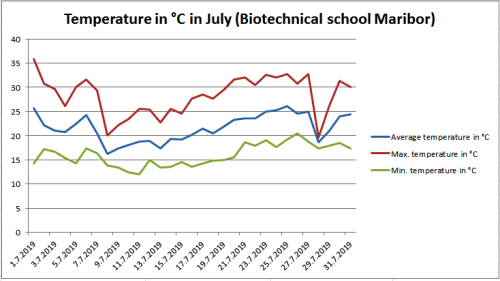
Precipitation data show that was much more precipitation in July than in June. In July fell 77 % more precipitation than in June, at the same time also more than the long-term average. The measuring device detected 130.2 mm of precipitation, which is higher as long as the long-term average (94 mm of precipitation). As compared to July 2018, there was twice as much precipitation. In the first seven months, 58 mm more precipitation fell than the long-term average. In the first seven months, fell 59.6 % of the long-term average precipitation. In comparison, last year only 3 mm less precipitation fell during this time.
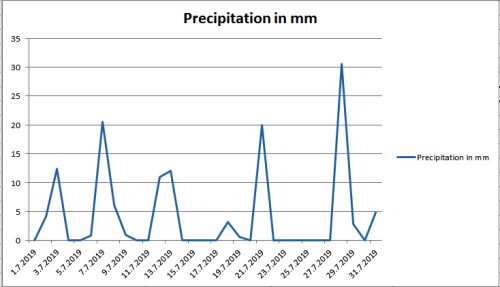
The average relative humidity in July was 72.93 %, which is slightly higher than in June and more than in July 2018 (68.72 %). Given much more precipitation, this was expected.
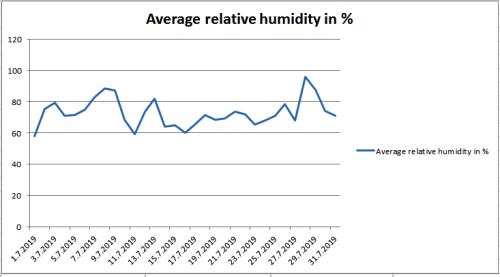
... link (0 Kommentare) ... comment
The difference between the highest (27th June) and the lowest (7th June) measured temperature in the month was as high as 22.9 °C.
The average monthly temperature was considerably higher than the average of the period from 1981 to 2010, it was 22.41 °C and it was 3.41 °C higher than the long-term average. The long-term average for June is 19,0 °C in Maribor. The average temperature was quite constant throughout the month. The difference between the average temperature of the coldest (23th June) and the warmest (27th June) day was as high as 7.99 °C. There were also great differences between night and day temperatures, even above 16 °C.
In June, the daily average temperature was only once below the average of the period from 1981 to 2010 (19.0 °C). The maximum temperature was above 20 °C all days, thereof twenty-five days above 25 °C, and thirteen days even above 30 °C. In June we had two heat waves in Maribor (the temperature must be at least three days above 30 °C). The first heat wave lasted for a whole week. The lowest temperature in June was 12.9 °C, and the highest temperature was 35.8 °C. In the first six months, the average temperature was 1.14 ° C higher than the long-term average. According to the ARSO measurement method, which is official for the whole of Europe (measurements at 7, 14 and 21 hours) was 0.87 °C higher.
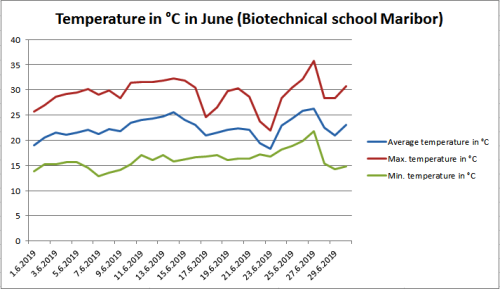
Precipitation data show that there was much less precipitation in June than in May. In June, half of the precipitation dropped, as in May, but also less than as the long-term average. The measuring device detected 73.6 mm of precipitation, which is much less as long as the long-term average (107 mm precipitation). In the first six months, 21.8 mm more precipitation fell than the long-term average.
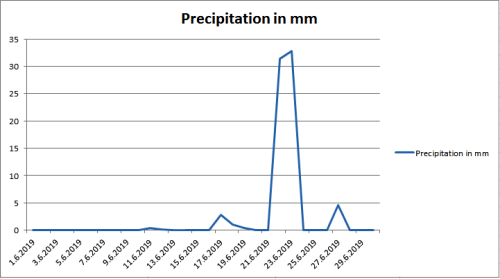
The average relative humidity in June was 68.98 %, which is less than in May and similar to 2018 (70.86 %). Given the less precipitation, this was expected.
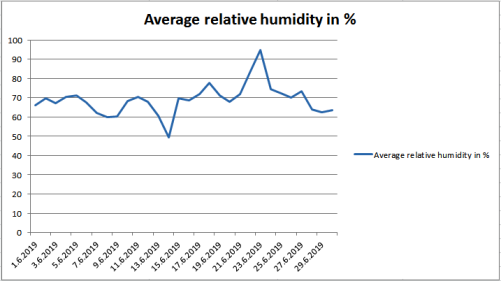
... link (0 Kommentare) ... comment
The average monthly temperature was lower than the average of the period from 1981 to 2010, it was 12.76 °C and it was 3.04 °C lower than the long-term average. The long-term average for May is 15.8 °C in Maribor.
In May, the daily average temperature was only seven times above the long-term average (15.8 °C). The maximum temperature was eleven times above 20 °C, thereof only two days above 25 °C. The lowest temperature in May was 1.9 °C and the highest temperature was 26.1 °C. In the first five months, the average temperature was 0.69 °C higher than the long-term average. According to ARSO, the measurement method, which is official for the whole of Europe (measurements at 7, 14 and 21 hours), was 0,43 °C higher.
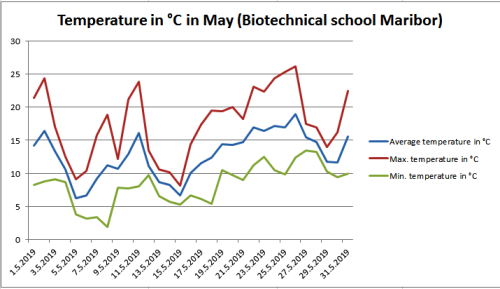
Precipitation during May was very rich with rain. In May, there were twice as much rainfall as the long-term average. The measuring device detected 158.4 mm of precipitation, which is more as long as the long-term average (83 mm precipitation). In the first five months, was 55.2 mm more precipitation than the long-term average.

The average relative humidity in May was 74.50 %, which is slightly more than in April. This was expected due to much more precipitation.
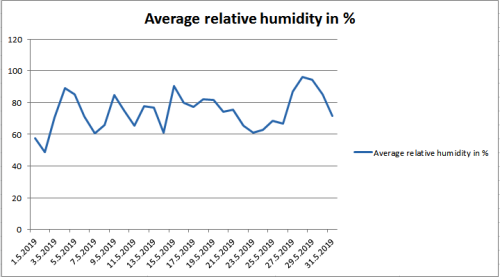
... link (0 Kommentare) ... comment
The average monthly temperature was somewhat higher than the average of the period from 1981 to 2010, it was 11.41 °C and it was 0.61 °C higher than the long-term average. The long-term average for April is 10.8 °C in Maribor. However, if we compare only the average temperature of the last week of the month with the average period from 1981 to 2010, it was found that it was 3.2 °C higher.
In April, the average temperature was thirteen times below the average of the period from 1981 to 2010 (10.8 °C). The maximum temperature was seven days above 20 °C, thereof only two days above 25 °C. The lowest temperature in April was 2.2 °C and the highest temperature was 25.5 °C. In the first four months, the average temperature was 1.62 °C higher than the long-term average. According to the ARSO measurement method, which is official for the whole of Europe (measurements at 7, 14 and 21 hours), it was 1.36 °C higher.
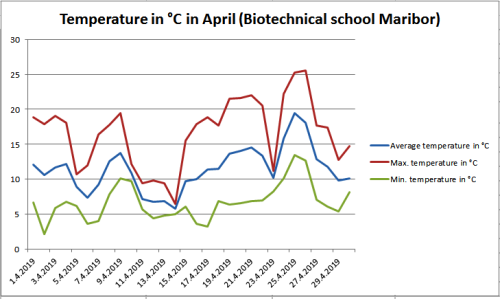
Precipitation data show that April was richer with precipitation. Precipitation during April was higher than average. The measuring device detected 79 mm precipitation, which is more than as long as the long-term average (60 mm precipitation). In the first four months was 20.2 mm less precipitation than the long-term average.
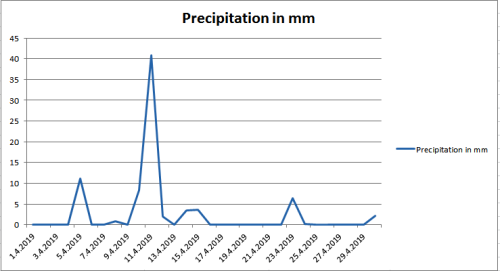
The average relative humidity in April was 70.10 %, which is slightly more than in March. Given the higher rainfall, this is expected.
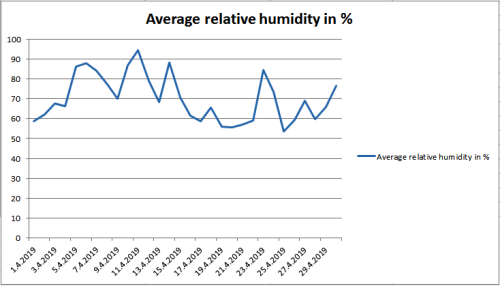
... link (0 Kommentare) ... comment
The average monthly temperature was significantly higher than the average of the period from 1981 to 2010, it was 8,59 °C, and it was 2,59 °C higher than the long-term average. The long-term average for March is 6 °C in Maribor. By comparison, in March 2018, the average temperature was 5.24 ° C lower. In the first three months of this year, the temperatures are quite different from the previous year.
The minimum temperature was only two days below the freezing point. The lowest temperature in March was -2.4 °C and the highest temperature was 22 °C.
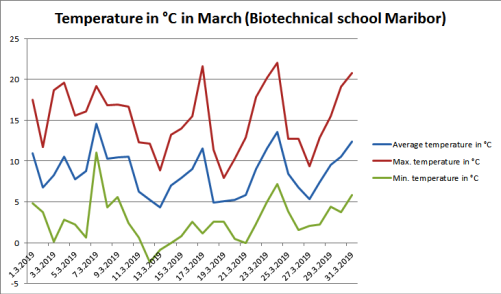
Precipitation data show that March was again below the average rainfall, as less precipitation fell than the long-standing average.
The measuring device detected 45.8 mm of precipitation, which is slightly less than the long-term average (57 mm precipitation).
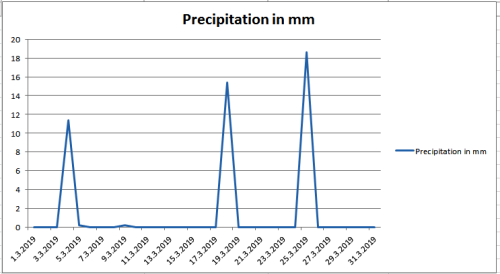
The average relative humidity in March was 63.4 %, which is not surprising given the smaller amount of precipitation.
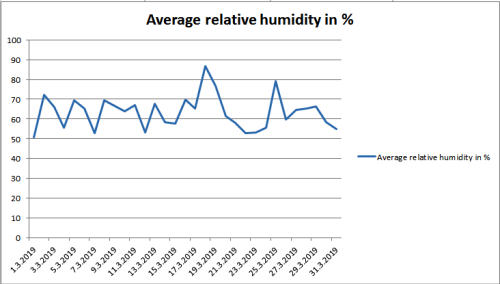
... link (0 Kommentare) ... comment
Yes!!!
Naturally, we used this lucky incident to spend the day outside.
In the morning we planted some herbs and flowers on the bee meadow. A local TV-channel was there and interviewed us about it. Guess you could call us almost famous!
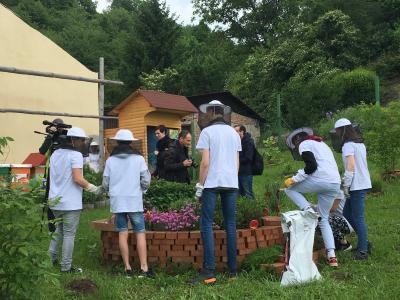
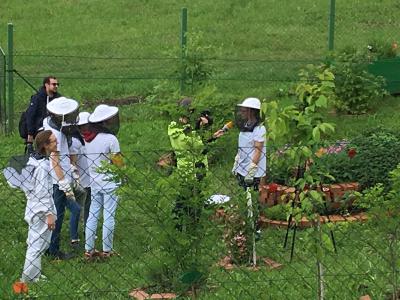
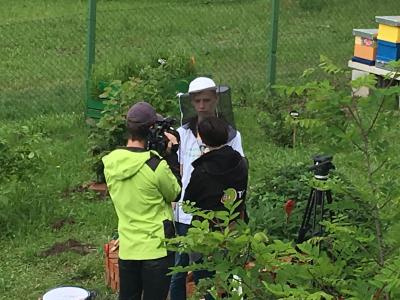
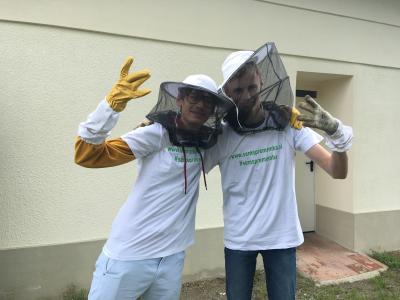
In the afternoon we climbed the Pohorje, Maribor's famous mountain (or hill, as they would say).
Okay, we took the cable car up and the bobsleigh down but there was some walking in between!
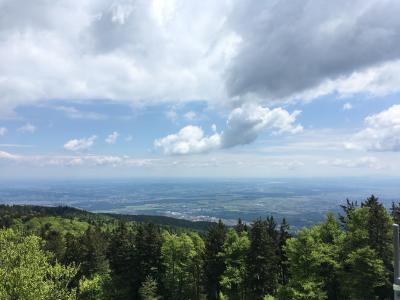
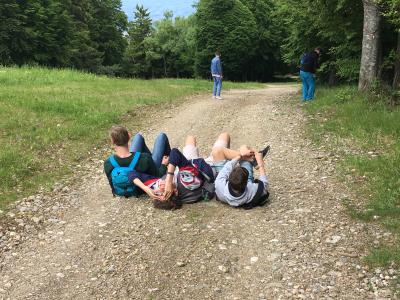
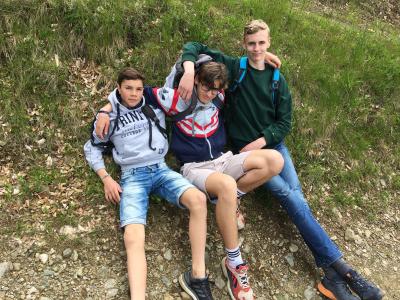
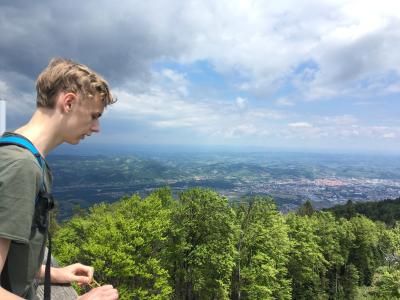
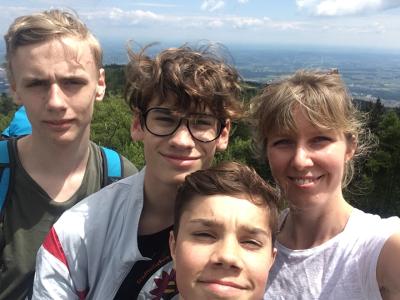
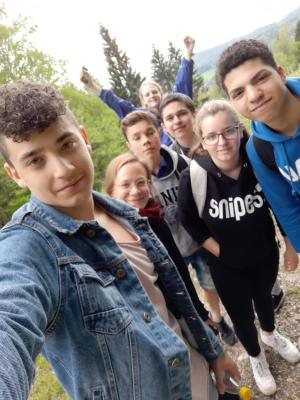
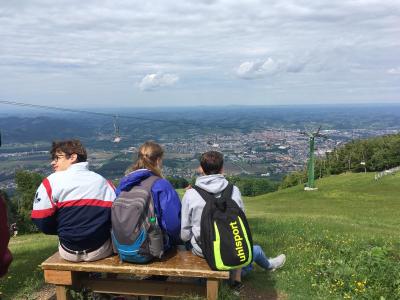
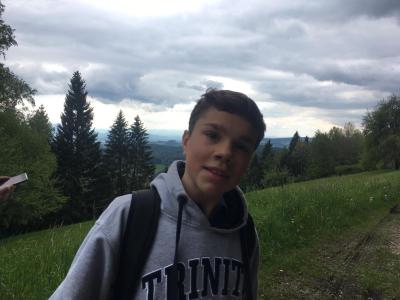
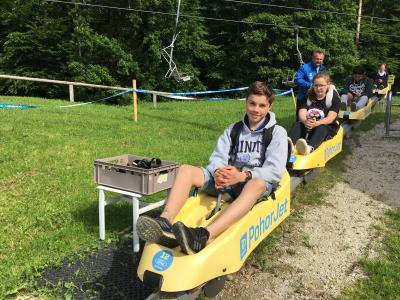
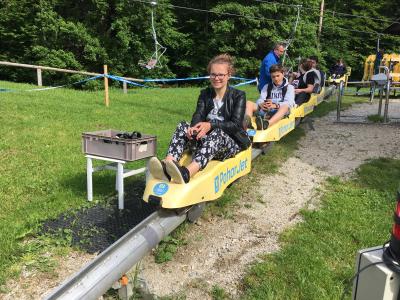
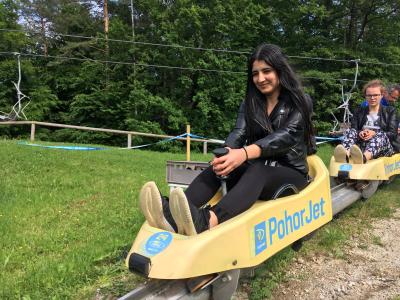

In the evening we had our good bye dinner at a lovely restaurant. There are no pictures of this, maybe because we were too busy crying ;)
We had a great time in Maribor and would like to thank everyone who was involved in organizing this perfect experience for us!
By now we are all back in Hamburg and we miss Slovenia already! Hope to see it again soon!
Bye for now and thank you for reading our blog!
... link (0 Kommentare) ... comment
Therefore, we baked some spoons again and assembled jars with panna cotta.
We also listened to a lovely lecture by 'evegreen', a company that produces bio-plastic tableware. That was really interesting!
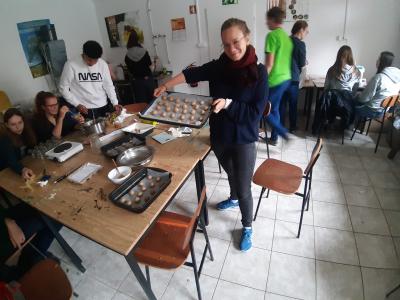
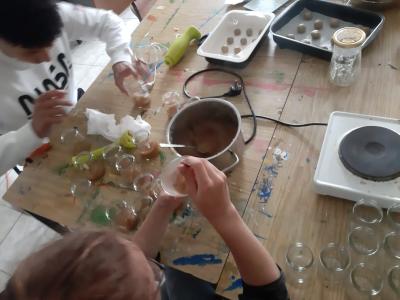
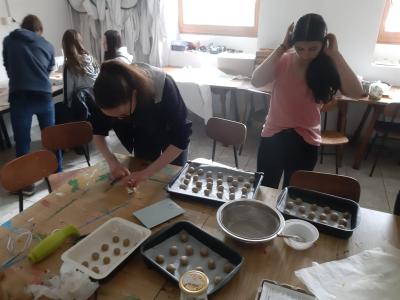
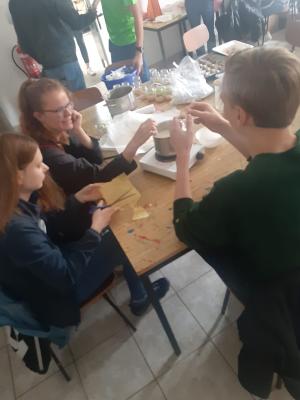

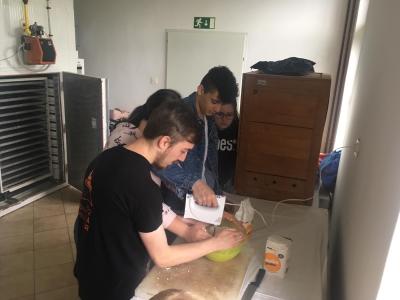
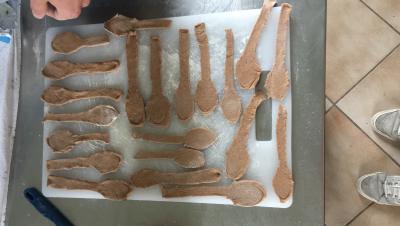
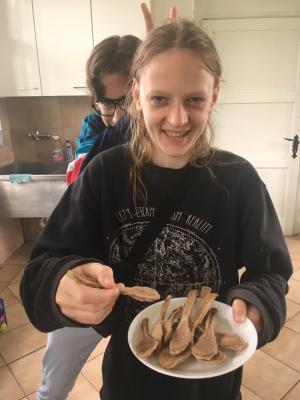
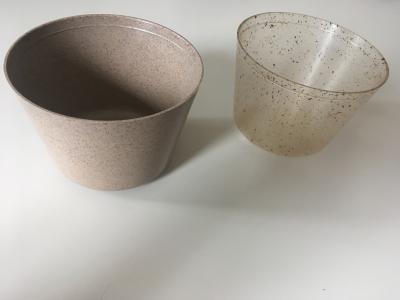
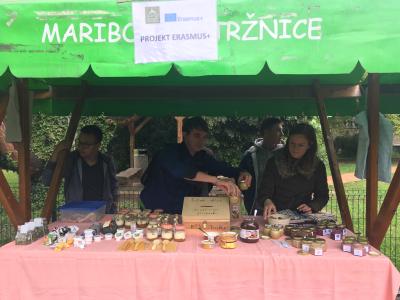
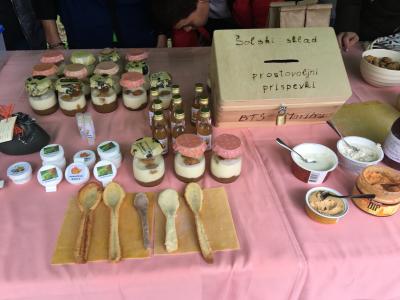
After the market, which was a huge success and offered many different regional products, we went into town for a special occasion - SWING NIGHT!
We had so much fun and everyone was dancing!
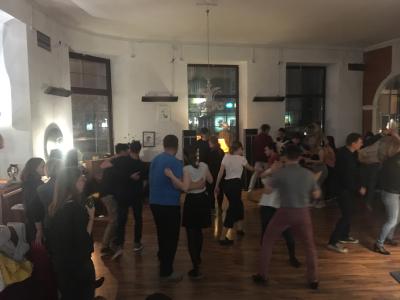
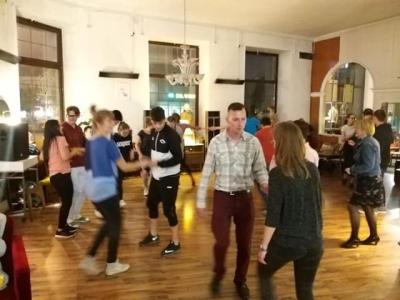
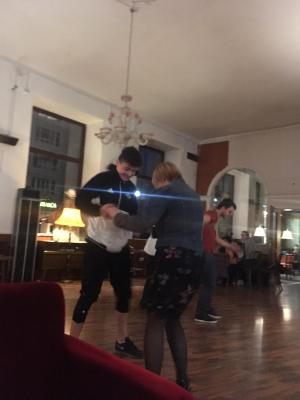
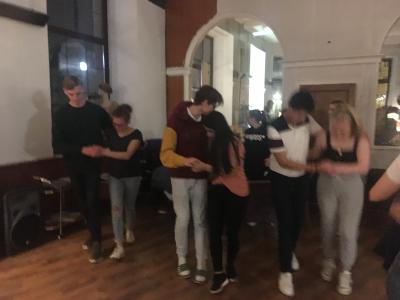


... link (0 Kommentare) ... comment
we try to convince the sun to show up through yoga!
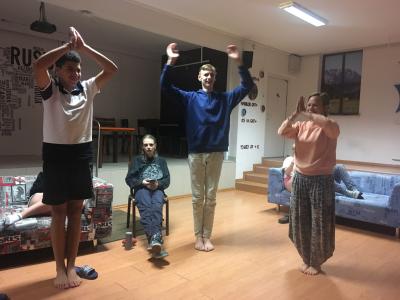
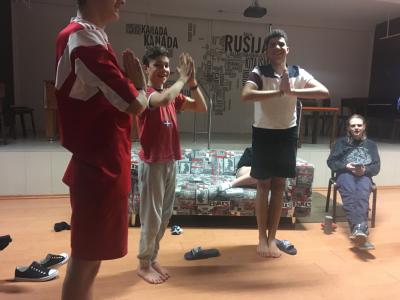
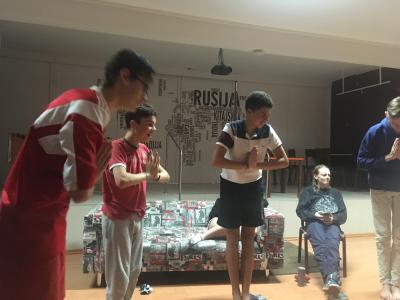
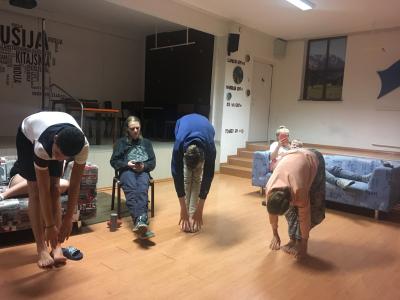
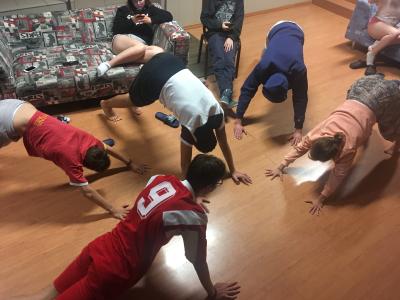

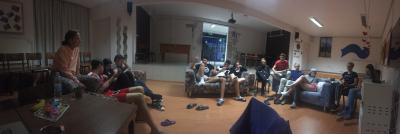
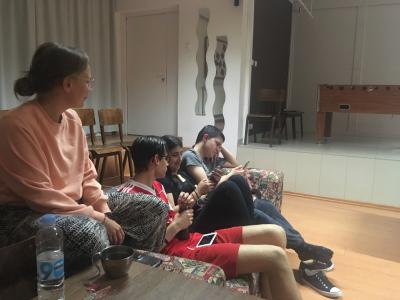
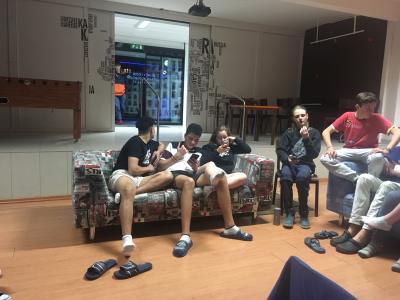
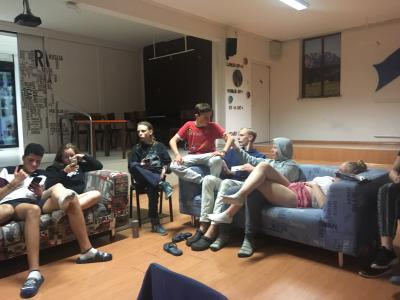
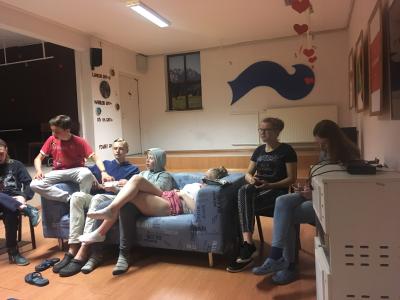
... link (0 Kommentare) ... comment
Today, we started with our daily morning meeting:
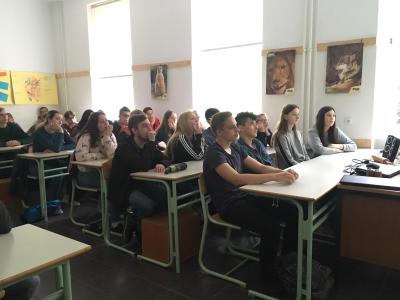
After that we divided ourselves into two groups and started with our workshops.
The first group made a herbal tincture out of camomile, mint, melissa, sage, thyme, garlic, cayenne, ginger, propolis, honey, alcohol (91%!) and some other ingredients.
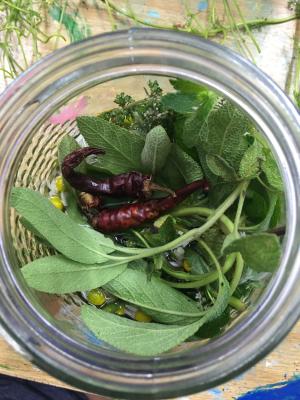
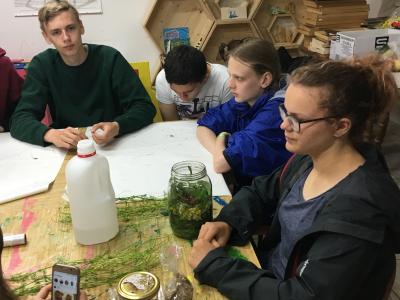
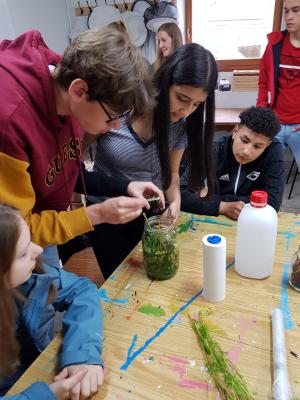
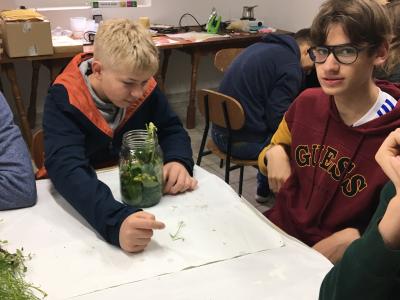
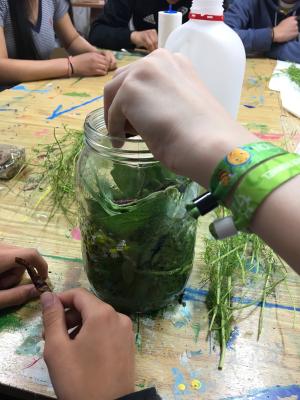
Also, we made lip balm and creams from bee wax, olive oil and honey:
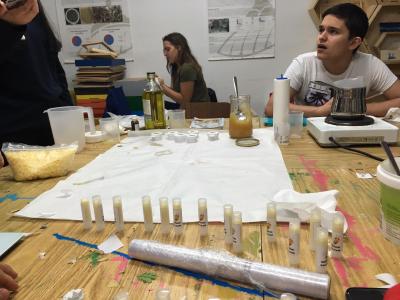
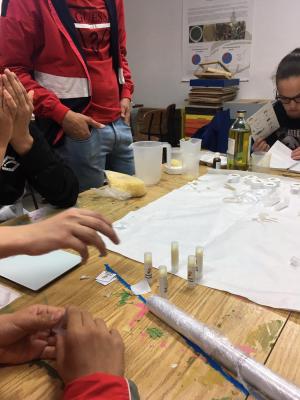
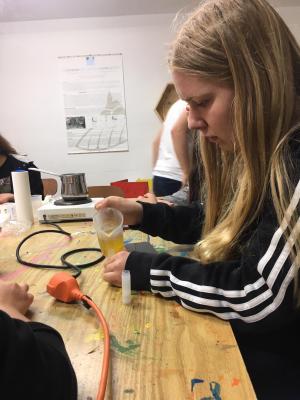
And, of course, we had a little honey tasting:
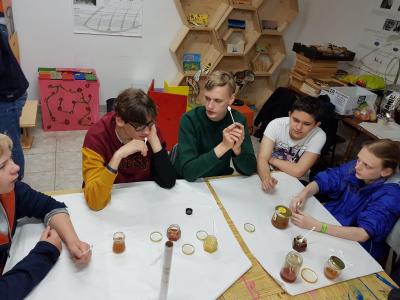
Nele showed us her hidden talent and sewed bags!
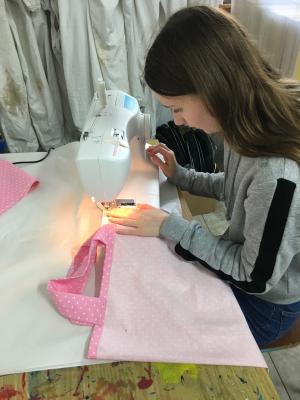
Our second group spent the morning in the kitchen to bake edible spoons!
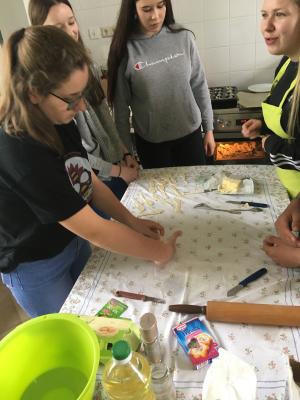
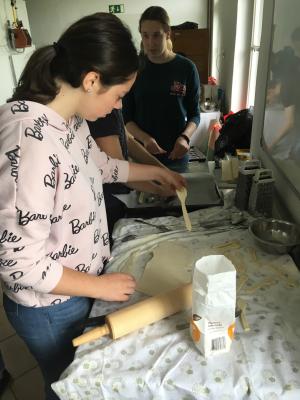
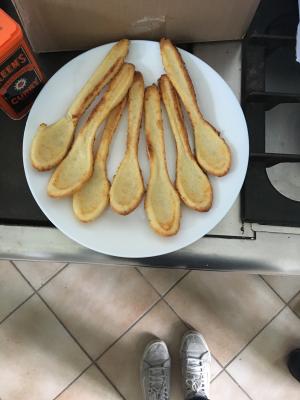
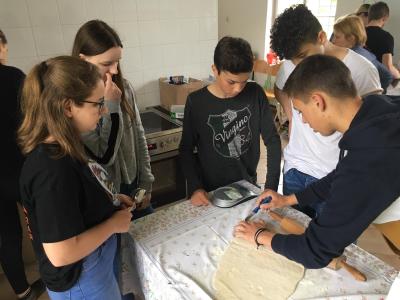
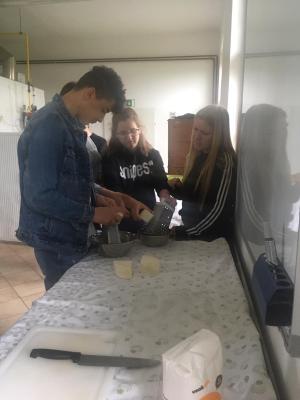
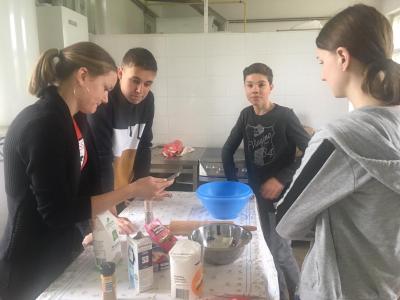
In the afternoon we went bowling together - that was fun!
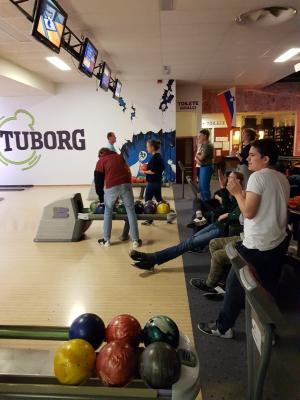
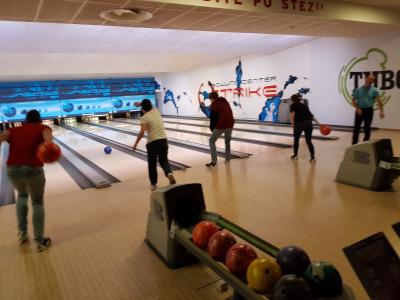
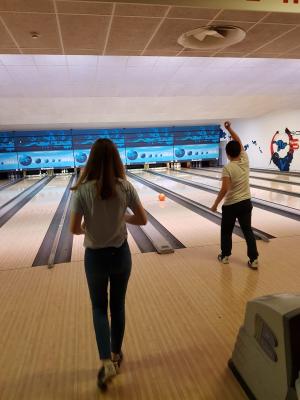
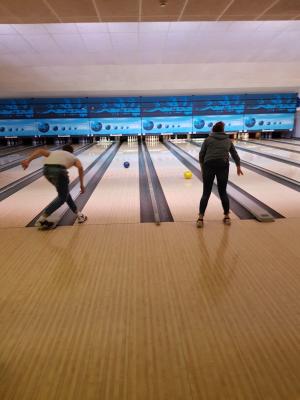

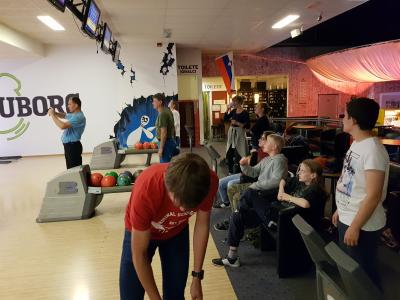
... link (0 Kommentare) ... comment
Luckily, this does not hinder our productivity.
Today, we helped to produce apple juice. André, Biotehniska's master of wine, cider and juice, gave us a great insight into his everyday work. We learned about the production of sparkling wine and apple juice and we were able to watch and assist the process from apple to juice in all its steps.
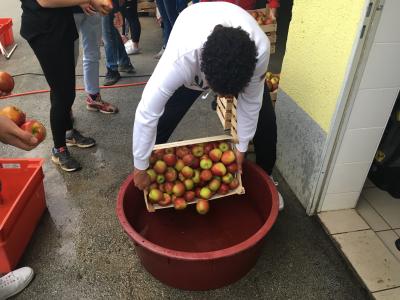
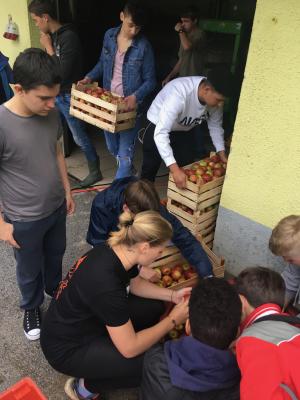
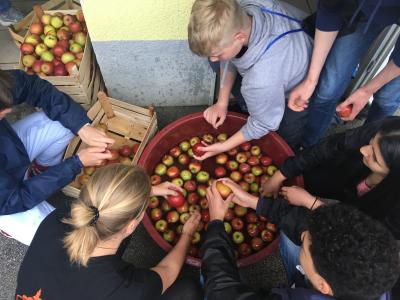
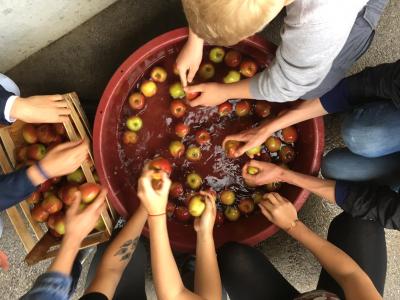
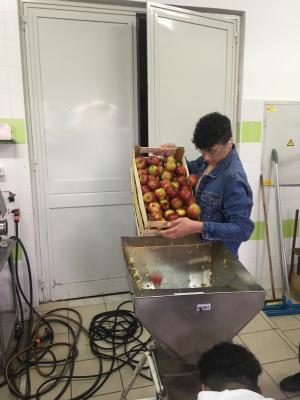
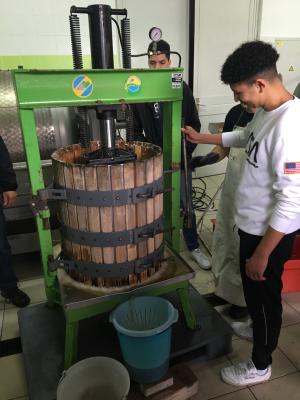
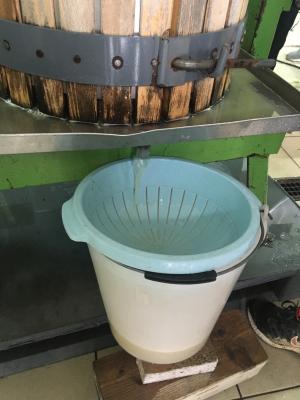
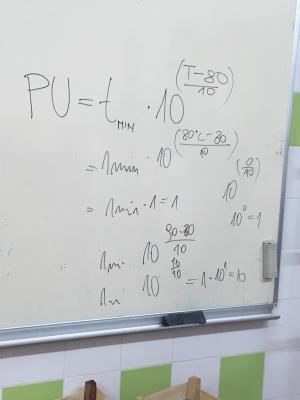
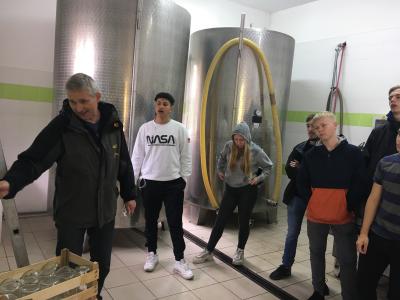
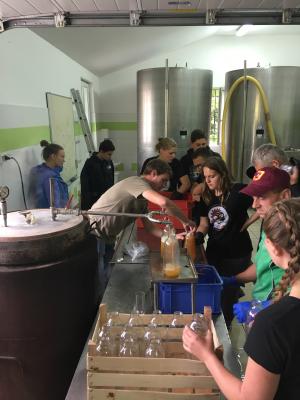
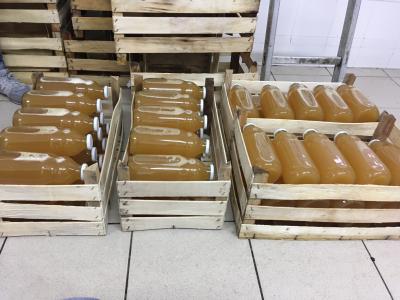
In the afternoon, we went to the Enigmarium, an escape room in Maribor.
We enjoyed this so much!
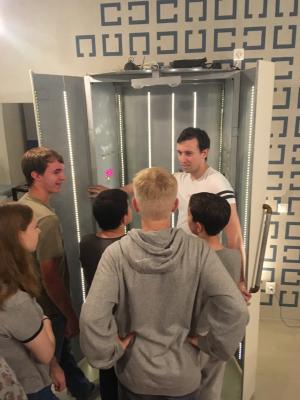
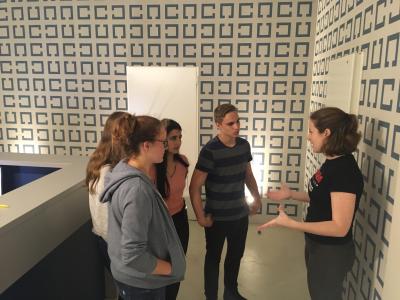
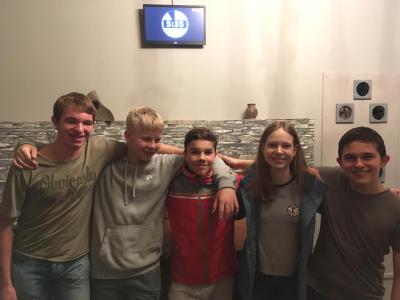
Also, here are some more pictures from our last days that the students took - enjoy!
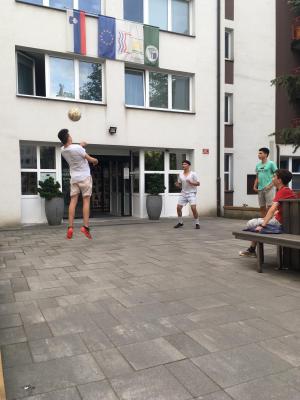
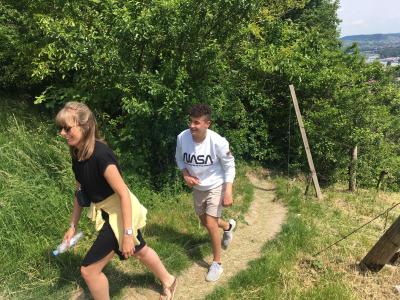
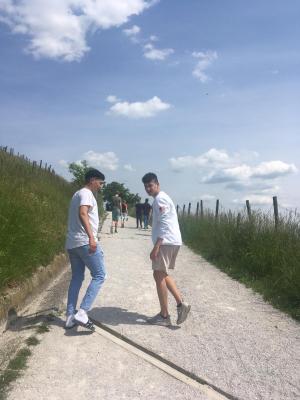
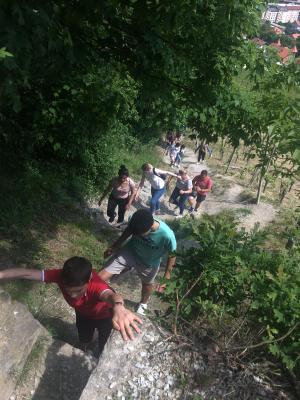

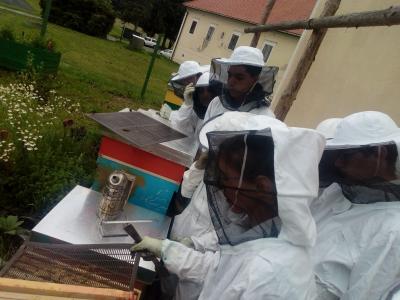
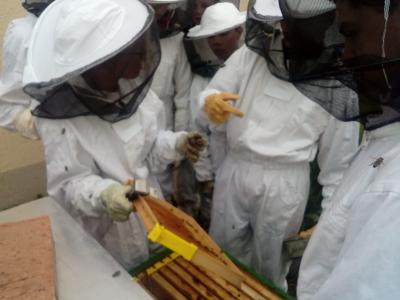
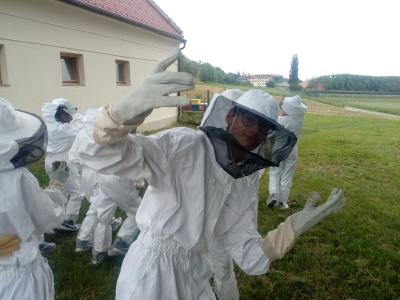
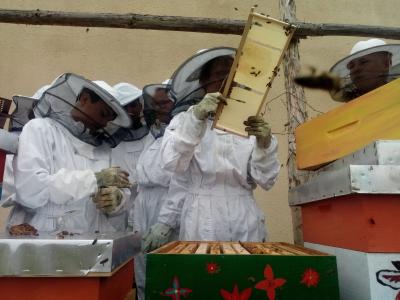
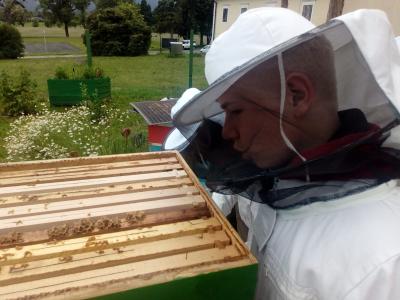
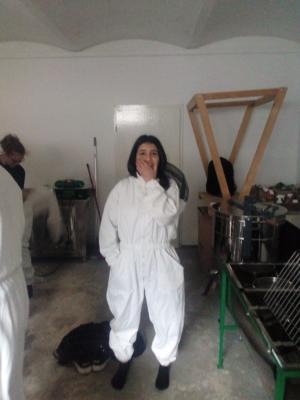
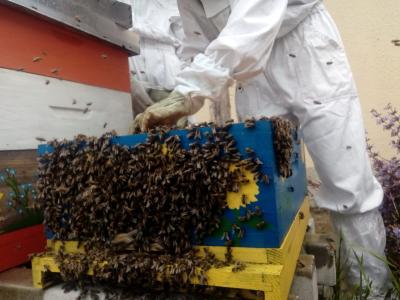
... link (0 Kommentare) ... comment
We started with some interesting videos that showed us the importance of BEEING FRIENDLY TO THE NATURE which is the motto of our program.
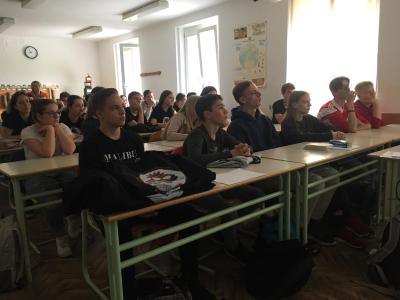
After that, the Slovenian students showed us the school property - including the animals!
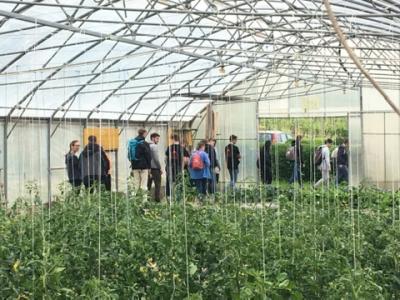
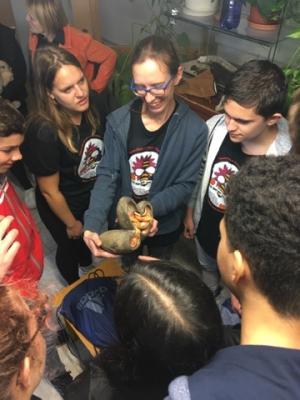
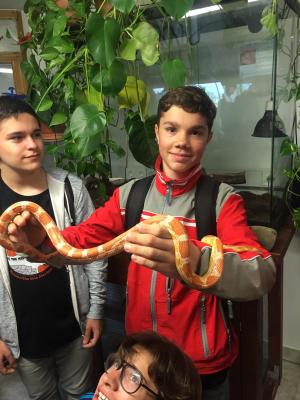
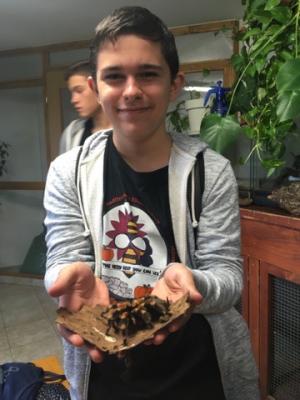
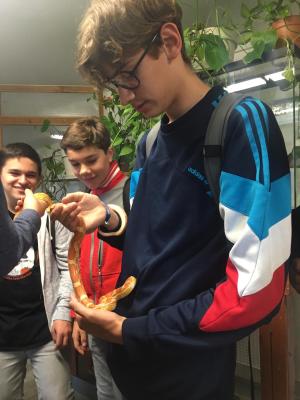
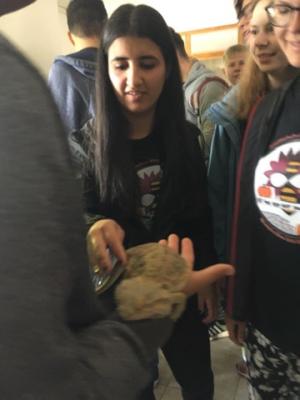

After our little tour we started our workshops:
Beekeeping
Painting Beehives
Building frames for Beehives
Take a look at the pictures!
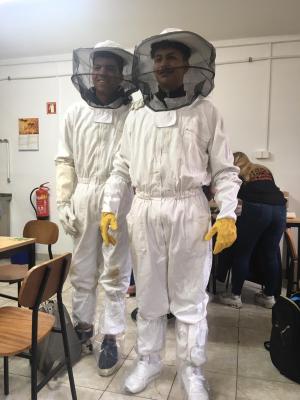
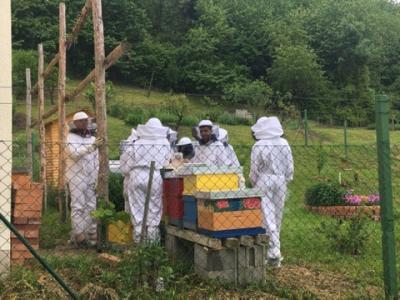
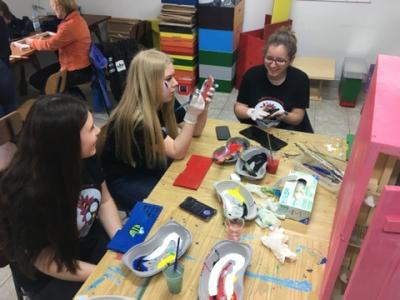
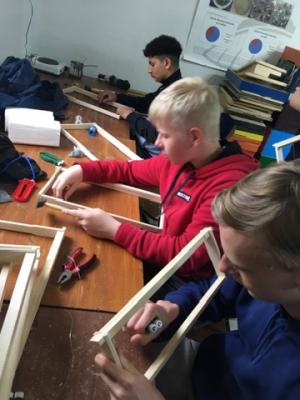
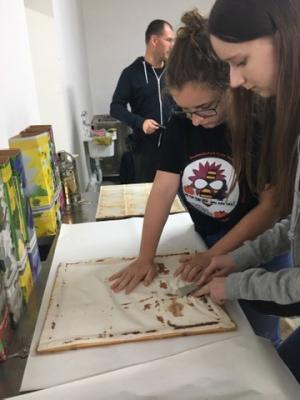
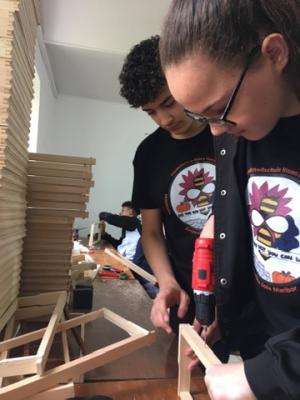
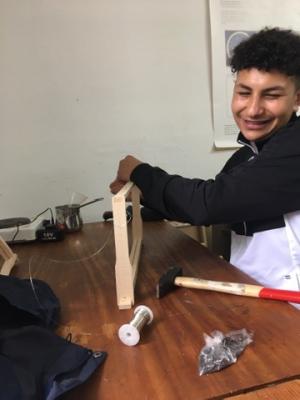
In the afternoon, we planned to go up Pohorje, Maribor's "hill" - or mountain, as we from the flat lands of Hamburg would call it - but unfortunately the rain crossed our plans. Instead we spend the time in the city and Maribor's shopping mall, the Europark.
Now we are playing games together - Werewolf!
... link (0 Kommentare) ... comment
First, we stopped at an ancient dripstone cave. This cave was the first touristic cave in Europe. The first visitors were sailors and traders in the 15th century. What an impressive sight!
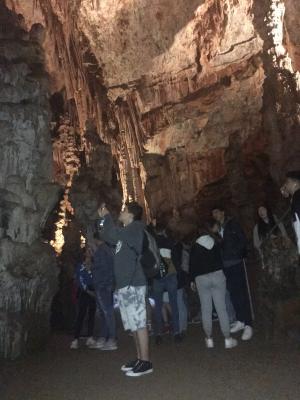
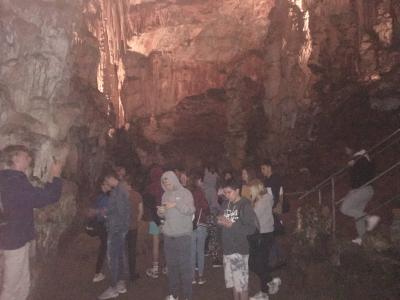
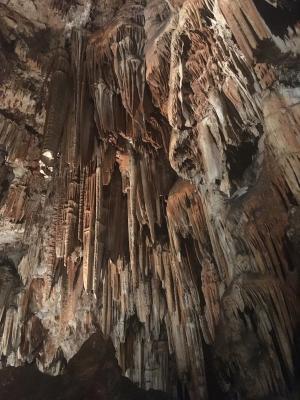
After that, we drove to Piran at the Slovenian coast. The Slovenian coast is only 42 km long but very beautiful! It looks a bit like Italy here, which makes since it's close to both the Italian and the Croatian boarder. In Piran we visited the shell museum and then we enjoyed some free time. Some of us even went swimming! (In 16 degrees cold water!).
In the end we had dinner at a pizza restaurant.
We had the best day - thank you to our Slovenian friends for organizing this lovely trip for us!
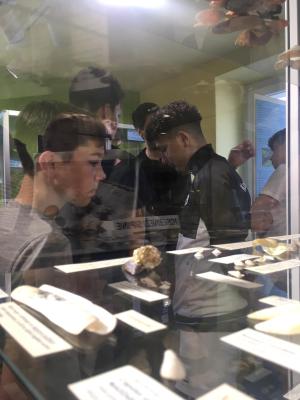
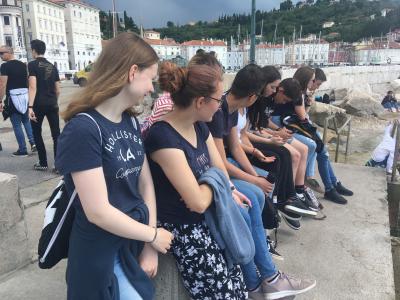
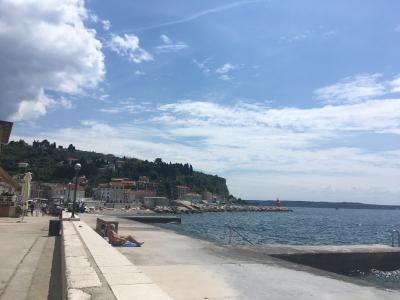
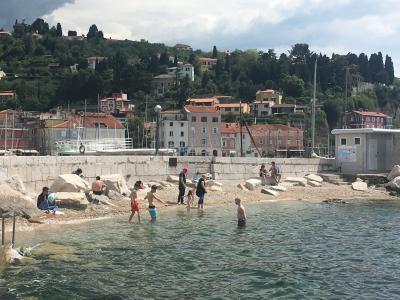
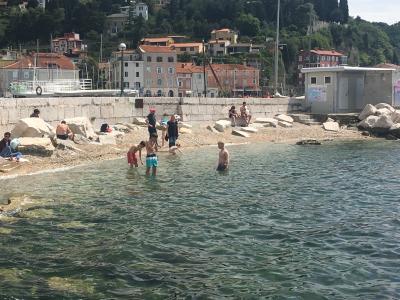
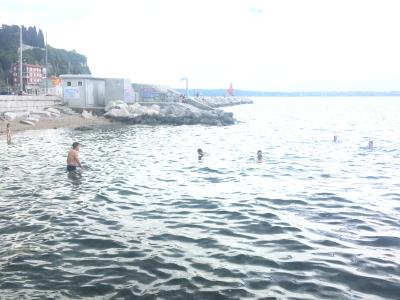
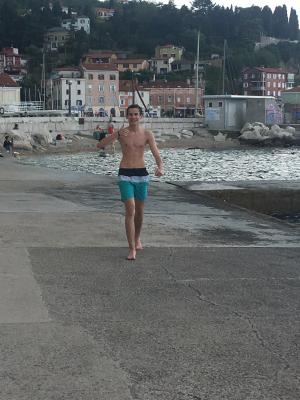
... link (0 Kommentare) ... comment
On Friday we took the train to Berlin where we slept one night. From Berlin we took an early flight to Graz yesterday where we were warmly welcomed by our Slovenian friends.
Here are some pictures from our journey:
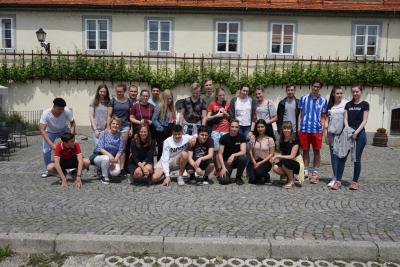
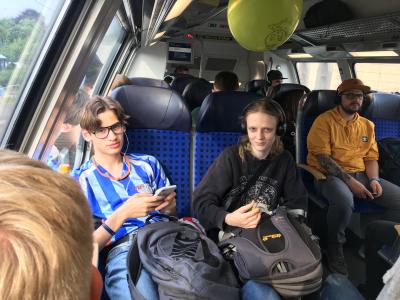
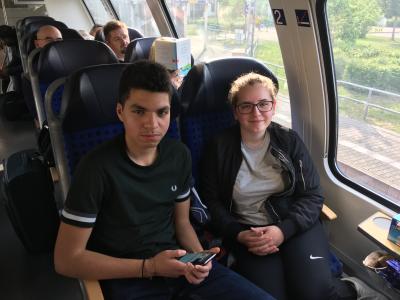

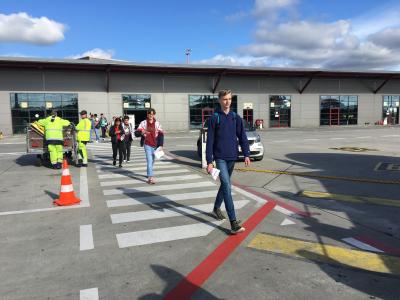
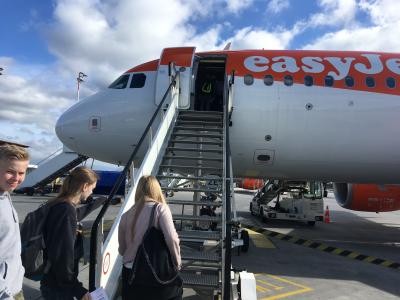
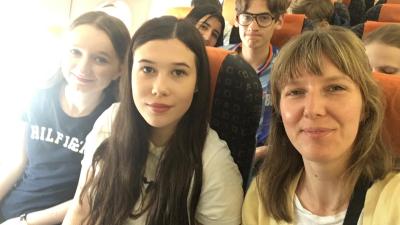
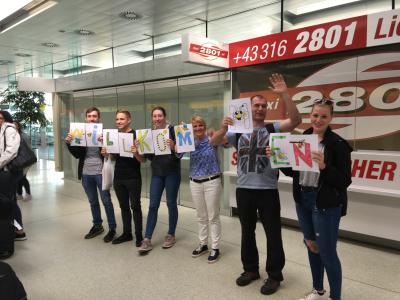
Later that day, our hosts showed us the city in incredible weather - what a treat!
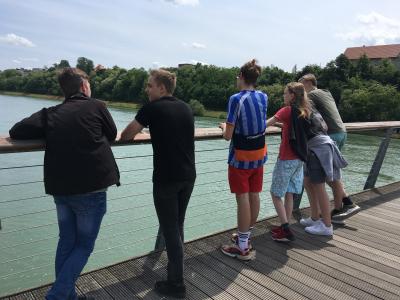
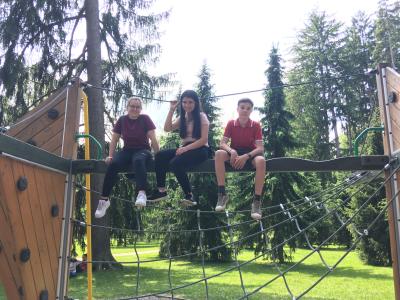
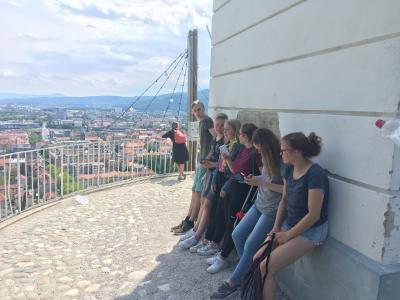
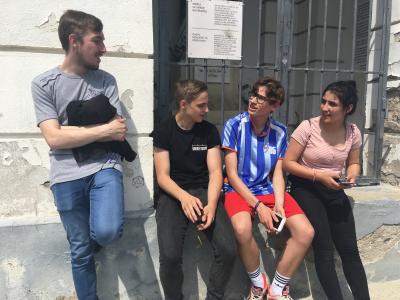
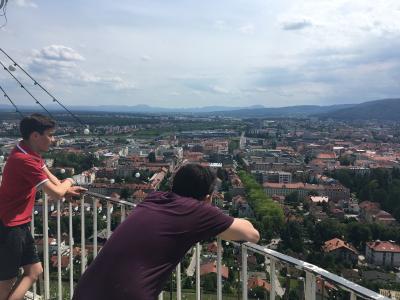
Finally, we had a lovely dinner in town, what an awesome first day!
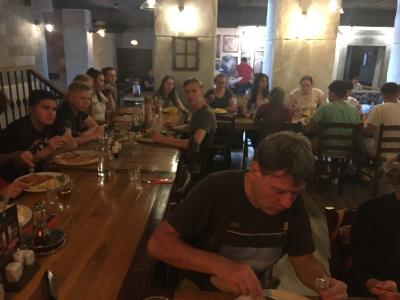

... link (0 Kommentare) ... comment
The Betnavski gozd is richer for different types of linden trees, cherry trees, chestnut trees, maple trees and rowan trees. The inhabitants, beekeepers, students of the Biotechnical School Maribor and students of the School of Wood and Forestry have planted forty honey trees.
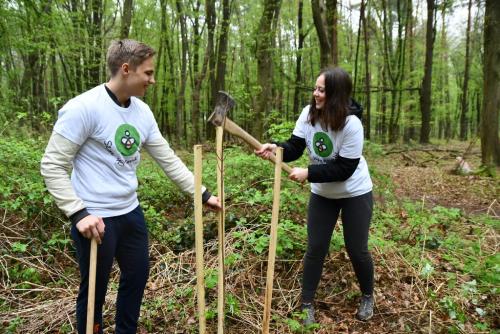
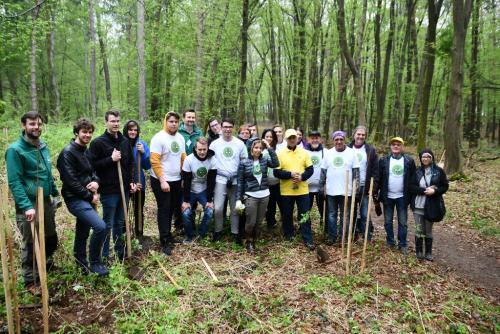
One of the roles of the forest is also to offer pastures for bees, which can be improved with tree species which blooming. The Biotechnical School Maribor is aware of this, so we joined the campaign “SEM SPREMEMBA”.
The campaign aims to encourage every person, company and institution, to plant at least one flowering plant. Each flower means food for bees, even if it is "just" a flower in a pot on a balcony terrace.
In May, the campaign will continue with the planting of nectar flowers and nectar shrubs at selected primary and secondary schools (also in the vicinity of our beehive).
Even in small gardens, from early spring to late autumn, bees can be harvested by pollen. In sunny places, bees are delighted with purple coneflowers, carnations, orange coneflowers, large-flowered tickseeds, New York asters, lavenders, sages, showy stonecrops ... In the shady areas of the gardens, bees are also interesting for black hellebores, lady's-mantles, astilbes,…
... link (0 Kommentare) ... comment
The most important task is to observe bee colonies before the hive entrance. If the bees do not fly out during the warm weather, or if the hive entrances are soiled with honey and wax, this is a sign that there is something wrong with bee's family. Last year's warm autumn and this year's warm winter active bee robbers. Two school families have also been robbed.
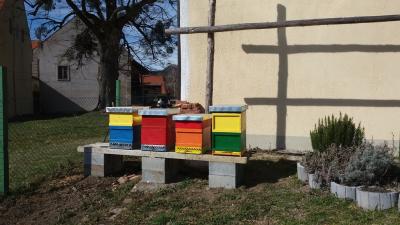
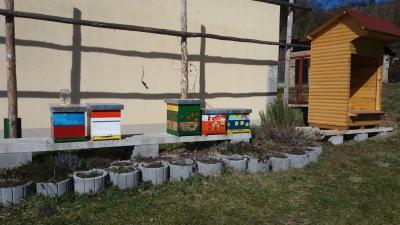
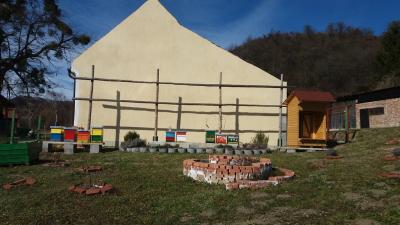
We have clened up the hives of robbed families with the students, while we added some frames with honey and sugar cakes (fondant block) to the rest families.
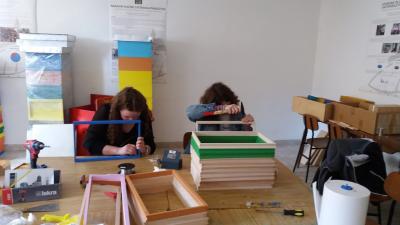
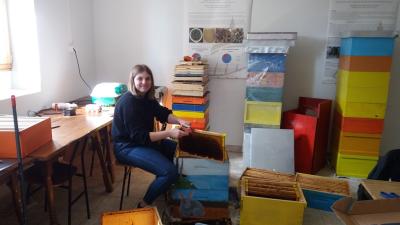
The students showed their artistic talent in painting hives. They also participate in the international art and literary competition.
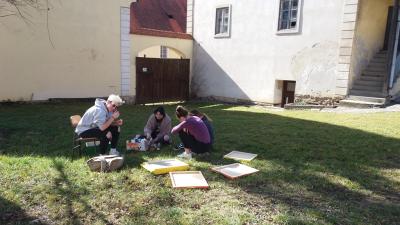
For the information day in our school and fair Altermed, we prepared several different types of cream honey (with raspberry, blueberry, cocoa, ginger and cinnamon). Our creamy honey always have a good response and almost of the experimenters like it..
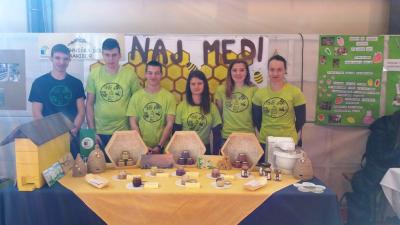
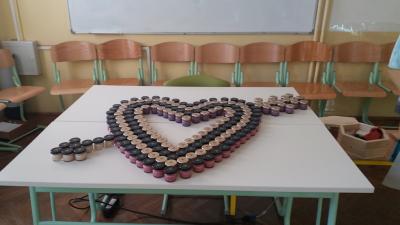
We also carried out honey analyzes at laboratory exercises. We measured the electrical conductivity of honey, the percentage of water in the honey, the amount of hydroxymethylfurforal in the honey, looking for pollen grains with pollen analysis of honey and performed sensory analysis of honey.
The bees were examined for Varroa Mites and Nosema.. We found that Varroa is constantly present, but does not endanger our families. We did not find Nosema in our samples.
With the research project Apitherapy with royal jelly we participated in the project Mladi za napredek Maribora.
We need to complete some other research tasks on the topic of beekeeping. We will present our tasks at a competition in the knowledge and skills of the Consortium of Biotechnical schools of Slovenia.
... link (0 Kommentare) ... comment
The highest temperature was 33.9 °C, which is far from the record temperature measured on the property, which was 40.6 °C (August 8th 2013). But the record mark (- 23 °C) approached the lowest temperature in 2018, which was - 20.2 °C.
In 2018 there were 27 days warmer than 30 °C, fortunately only five days were such that even the lowest daily temperature did not fall below 20 °C (tropical night).
In the year 2018, precipitation was only 784.6 mm, which is much less than the 30-year average (893 mm). The highest precipitation was recorded in 1962 (1304 mm) and the lowest in 2011 (604 mm).
In 2018 we only had one very rainy day when 78.6 mm of precipitation fell (4. 5. 2018). Especially in the first half of the year, we felt that the rain was falling steadily (93 days of precipitation), but it should be emphasized that 31 days were of such occurrence as less than 1 mm precipitation fell. So we can say that it is often only a rosé, which does not greatly benefit the plants or can even harm them if the temperature is high enough (the possibility of mold and rust).
You can find more detailed information in the attachment.
weather_report_maribor2018 (pdf, 150 KB)
Comparison of average monthly temperatures in 2018 with the long-term average of the period 1981-2010.
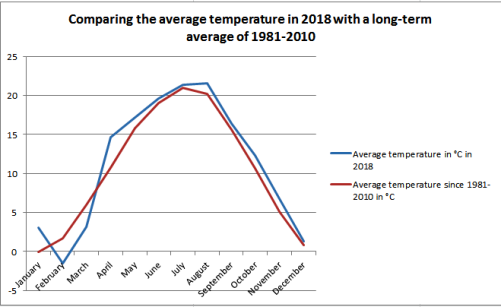
Comparison of precipitation in 2018 with a long-term average of the period 1981-2010.
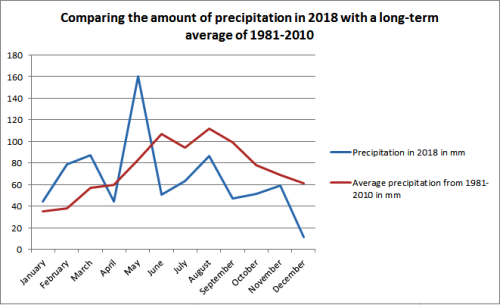
... link (0 Kommentare) ... comment
The difference between the highest (28th February) and the lowest (7th February) measured temperature in the month was as high as 31 °C. From this, we can understand, that we had cold nights and mornings and too high daily temperatures.
The average monthly temperature was much higher than the average of the period from 1981 to 2010, it was 4,7 °C, and it was 3 °C higher than the long-term average. By comparison, in February 2018, the average temperature was - 1.41 °C (6.11 °C lower). The long-term average for February is 1.7 °C in Maribor. If we compare only the average temperature of the second half of the month with the average period from 1981 to 2010, we can see that it was higher by 4.53 °C.
In February, the average temperature was only five times below the freezing point (0 °C). The maximum temperature did not reach even the freezing point. The minimum temperature was nine times above the freezing point. The lowest temperature in February was - 8 °C, and the highest temperature was 23 °C. Compared to February 2018, the lowest temperature was - 20.2 °C and the highest was 11.58 °C.
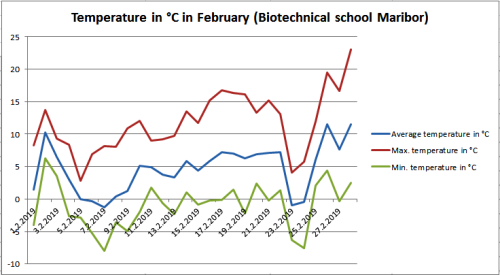
Precipitation data show that the trend of falling precipitation is still continuing. There was no snow fall at all, therefore drought is expected in March, especially in cereals (barley, wheat).
In February there was less precipitation than a long-term average. The measuring device detected only 16.2 mm of precipitation, and the long-term average is 38 mm precipitation. Most precipitation dropped in the first half of the month. In February 2018, dropped 78.6 mm of precipitation and 106.8 cm of snow.
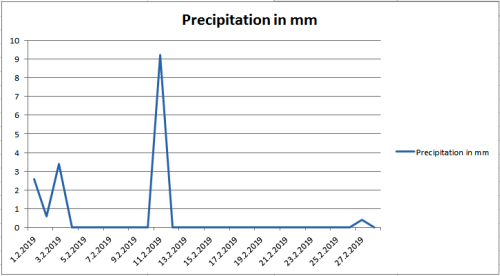
The average relative humidity in February was 67.85 %, which is even less than in January. In February 2018 it was as much as 86.42 %.
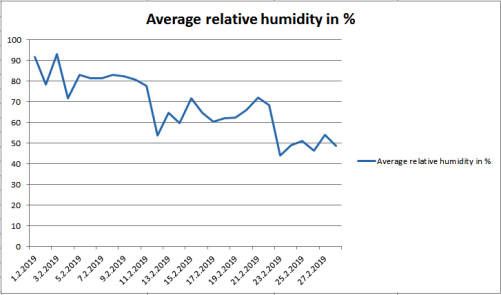
... link (0 Kommentare) ... comment
The difference between the highest (January 17) and the lowest (January 26) measured temperature in the month was 23.3 °C.
The average monthly temperature was higher than the average of the period from 1981 to 2010, it was 0.17 °C and it was 0.27 °C higher than the long-term average. The long-term average for January is - 0.1 °C in Maribor. For comparison, in January 2018, the average temperature was 2.87 °C.
The difference in average temperature between the coldest (January 26) and the warmest (January 17) day was 12.38 °C.
In January, the average temperature was fourteen times below the long-term average (- 0.1 °C). The maximum temperature was three days above 10 °C, and only two days below 0 °C. The lowest temperature in January was - 9.6 °C and the highest temperature was 13.7 °C.
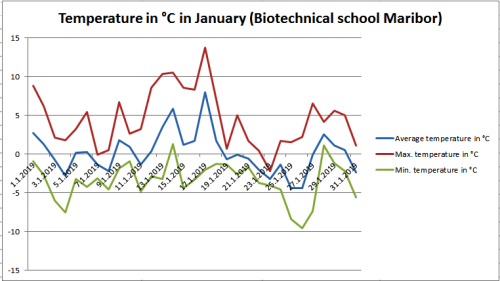
Precipitation data show that there was very little precipitation in January, which has been happening for more than half a year. The problem is that there were no snowfalls, which represent a stock of water for the spring months. There were seven rainy days, with 28.8 mm of precipitation, which is less as long as the long-term average (35 mm of precipitation). In January 2018, fell 44.4 mm of precipitation.
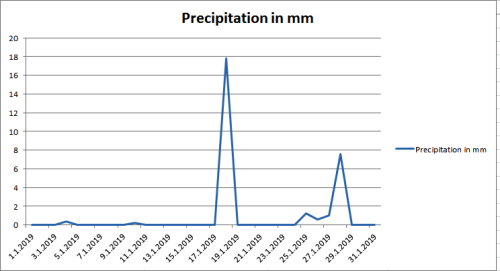
The average relative humidity in January was 77.22 %, which is less than in January 2018 (85.28%). Given the lower amount of precipitation this is normal. In January there was a significant fluctuation in air humidity, with only 55 % to 93 % of moisture.
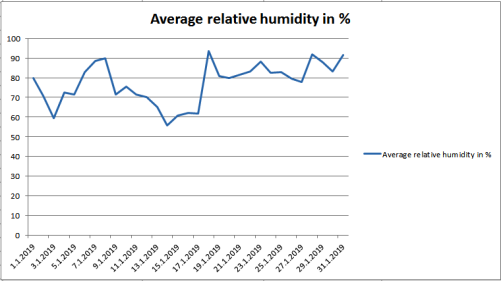
... link (0 Kommentare) ... comment
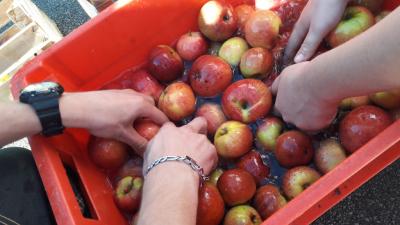
then we put them in a box and washed again.
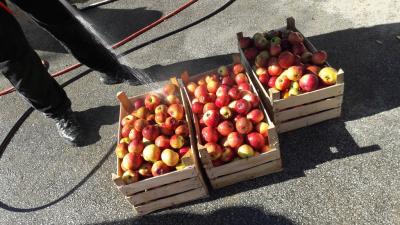
Then we crushed them in a mill
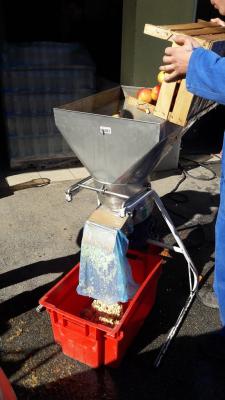
and mash transferred into the press.
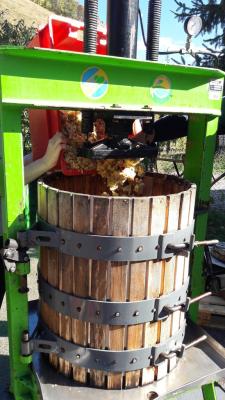
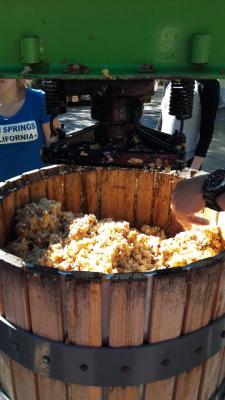
We squeezed the mash to 150 bars. The apples were overripe, so we squeezed out less juice than we expected.
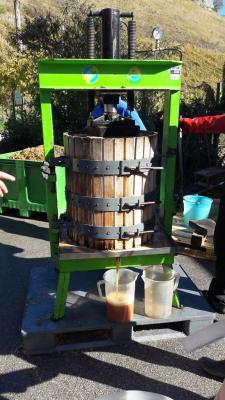
From 80 kg of apples we extracted 22 liters of apple juice. The juice was poured into a bowl through the strainer in which he waited until the next day.
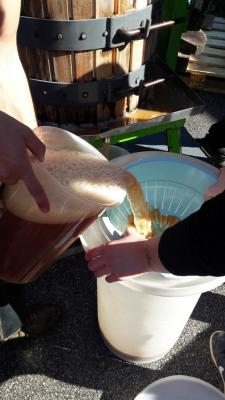
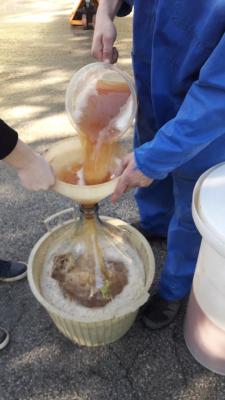
Overnight, the larger pieces of apples saturated. We did not add any additive to juice.
The next day, we pasteurized juice.
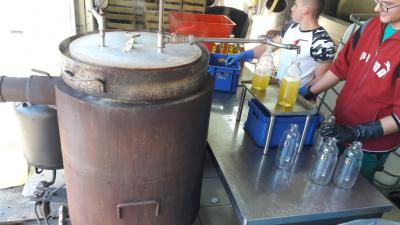
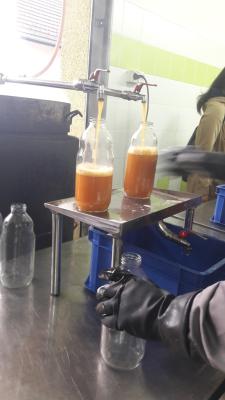
We prepared 14 liters of cloudy apple juice. The juice was pasteurized at 86 °C. When bottled it had a temperature of 78.8 °C, which dropped below 70 °C after 11 minutes. The bottles were closed with a stopper, and then laid for 1 minute to make the stopper disinfect. The bottles were cooled below 30 °C in cold water and dropped in wooden box.
... link (0 Kommentare) ... comment
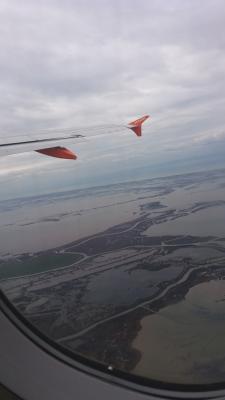
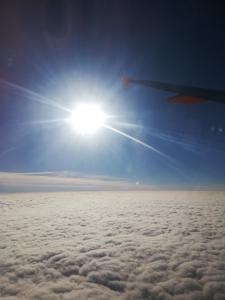
The plane ride took about 2 hours so we arrived in Hamburg at 16:00 o'clock. At the airport, the students from Rissen were waiting for us with a sign that said: »WELCOME TO HAMBURG«. That was a friendly welcome from them. Later, we went to the hostel to check-in and get our stuff out of the bags, had dinner, where student from Germany joined us, so we could get to know each other.
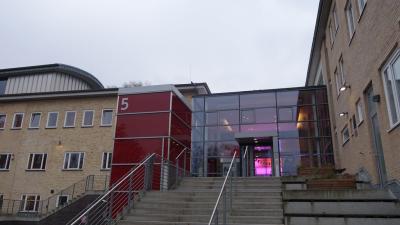
Our week in Hamburg was really interesting. Each day we woke up at 7.30 am and went to their school by train in the morning. At their school we worked on different start up projects,
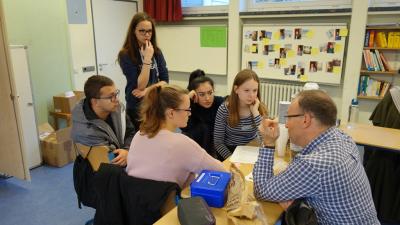
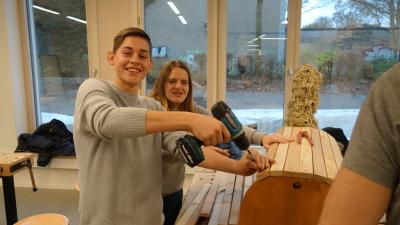
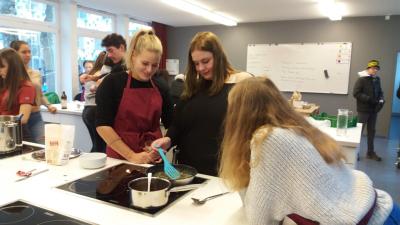
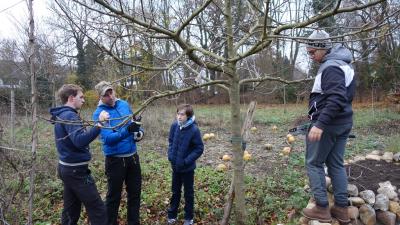
prepared the material for Autumn Market in their workshops,
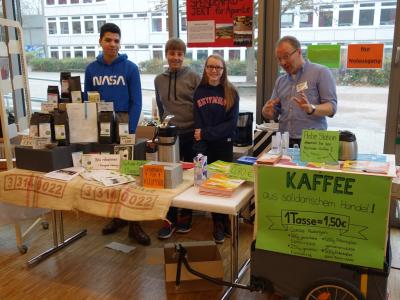
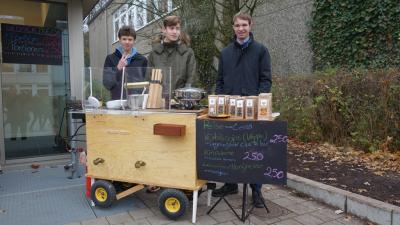
went to their classes to see how they learn, exchanged experience and knowledge, learned from each other a lot,
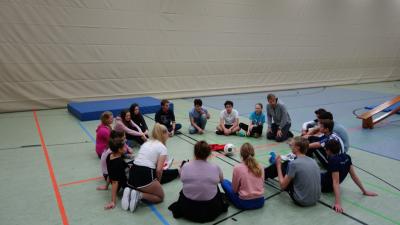
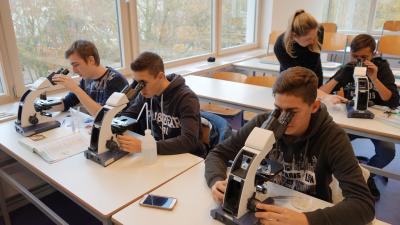
but also played outside, had fun. …It was amazing!!! After school we usually had some fun activities: Dialogue in the dark (extraordinary, unforgettable 90 min experience in the skin of blind people),
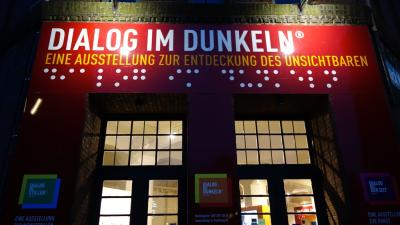
ice skating,
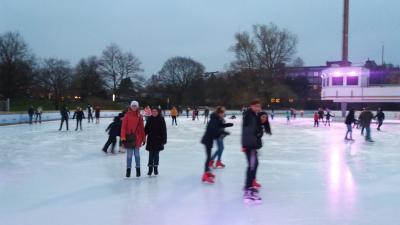
sightseeing tour,
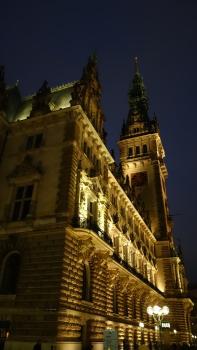
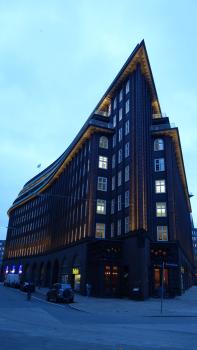
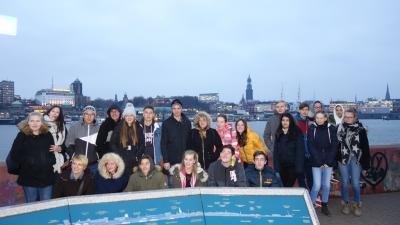
basketball game, romantic boat trip,
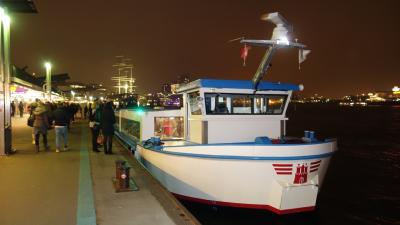
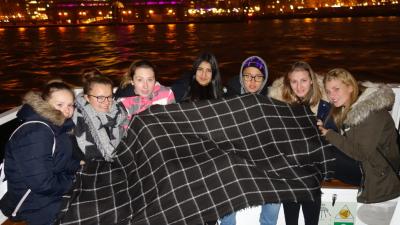
selfie rally,
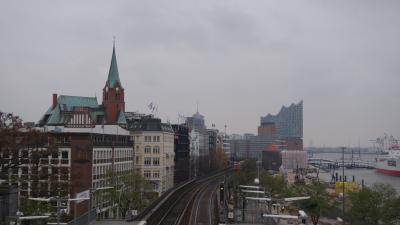
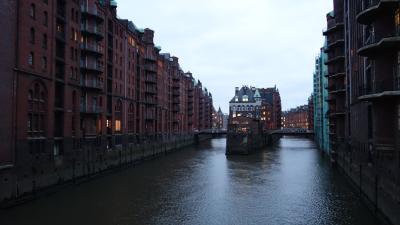
museum,… In the evening we hang out and went out to eat at different restaurants an (Mr. Kebab, Peacetambul…)
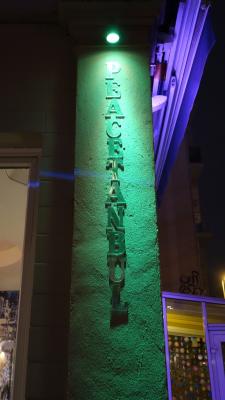
or we just went to the park DOM, which was the biggest amusement park I had ever seen.
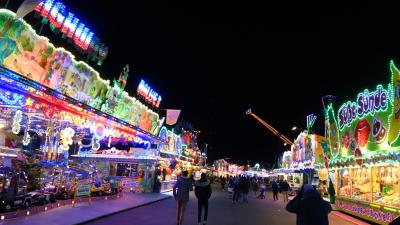
But sadly our time to go home came too quickly, like 1,2,3 and boom Sunday was just around the corner. Of course, everybody was really sad that it was time to leave Hamburg because we met a lot of amazing people, who we never thought we could have met. So when we were getting ready in the morning (packing our luggage) our friends from this year's project and last's year project came to surprise us at the hostel. They wanted to spend the whole day with us, because we had time before our flight back. We decided to go to the city and the museum and do some sightseeing before we went home.
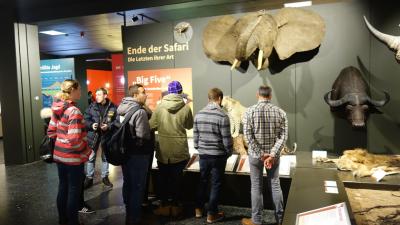
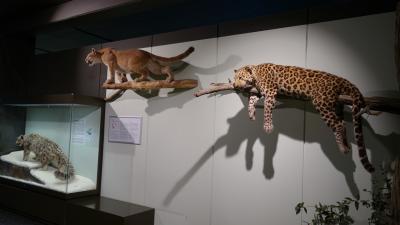
Our tour of the city ended at 16.00 o'clock when we had to go to the airport. Some of them even came to the airport with us to say our last good-byes. It was a truly sad moment when we were leaving Hamburg because we met so many great people. Some of us even cried, but we promised each other to stay in contact or even visit without school.
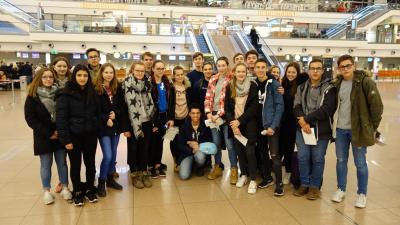
We boarded our plane and landed in Italy, Venice. The last thing was the car ride back home which took about 4 hours. We arrived in Slovenia at 1.30 in the morning. Tired, but full of unforgettable memories.
... link (0 Kommentare) ... comment
The difference between the highest (December 4) and the lowest (December 16) measured temperature in the month was as high as 26.4 °C. This is not such a big surprise, given the very high temperature fluctuations throughout the month.
The average monthly temperature was significantly higher than the average of the period from 1981 to 2010 – it was 1.09 °C, and it was 0.29 °C higher than the long-term average. The long-term average for December is 0.8 °C in Maribor. The average temperature fluctuated throughout the month. The difference between the average temperature of the coldest (December 16) and the warmest (December 4) day was 12.21 °C. The differences between night and day temperatures were reduced. The difference ranged from 1 to 15 °C, and on average the differences were greater than in November. In December the difference was 9 °C (In November 6 °C).
In December, the daily average temperature was fifteen times below the average of the period from 1981 to 2010 (0.8 °C). The maximum temperature was six days above 10 °C, one day above 15 °C, and only two days below 0 °C. The lowest temperature in December was -10.5 °C, and the highest temperature was 15.9 °C. In the last month, the average temperature dropped by 0.06 °C in relation to the long-term average.
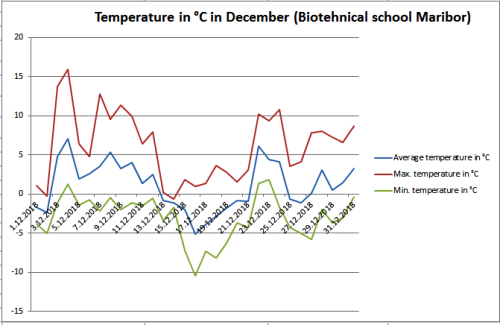
Precipitation data show that there was very little precipitation in December, which has been happening for more than half a year. In December, only 19 % of the precipitation dropped, as is the long-standing average. The measuring device detected 11.6 mm of precipitation, which is much less as long as the long-term average (61 mm of precipitation).
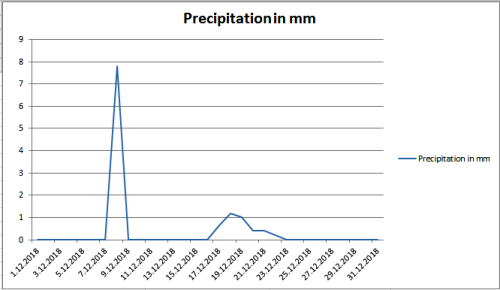
The average relative humidity in December was 81.98 %, which is less than in November. For December, there was a significant fluctuation in relative humidity (between 63 % to 95 %). Interestingly, only 88 % of moisture was in the air, on the only real rainy day of the month.
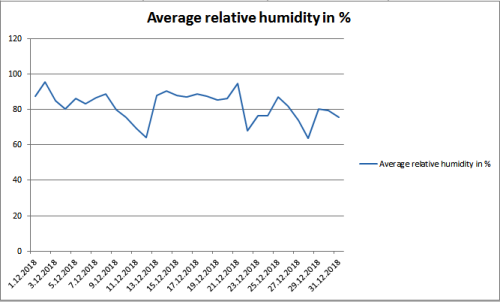
... link (0 Kommentare) ... comment
First we sorted the apples. For apple juice we selected apples with a diameter of less than 6 cm and damaged apples. We have prepared the best quality apple for sale.
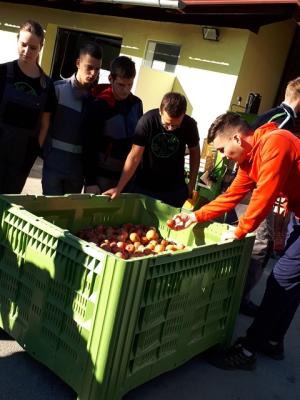
Then all the apples were washed. Water was poured into a larger container and each box of apples washed separately. Apples were ready for grinding.
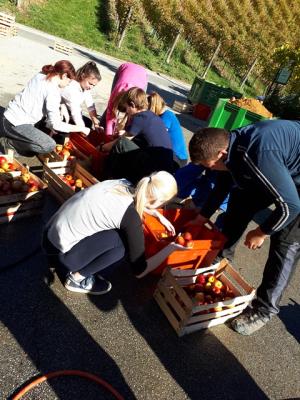
We milled the apples with an electric mill. We poured the apples into a mill, which was crushed into a pulp, which we intercepted in a plastic box.
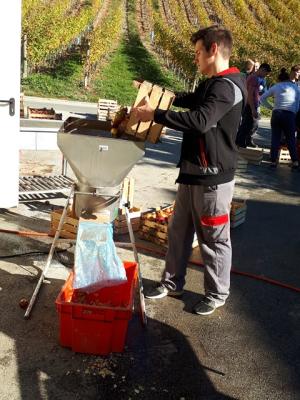
We poured a apple pulp into a hydraulic press.
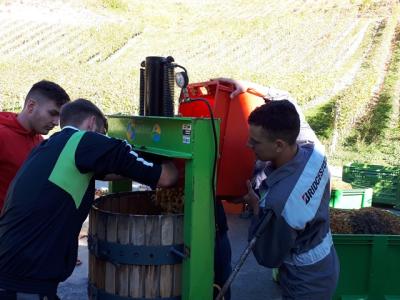
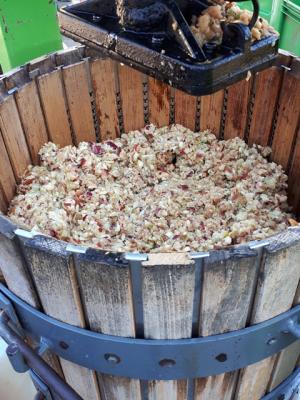
When the pressure rose, the apple pulp began to squeeze and, consequently, the juice began to flow.
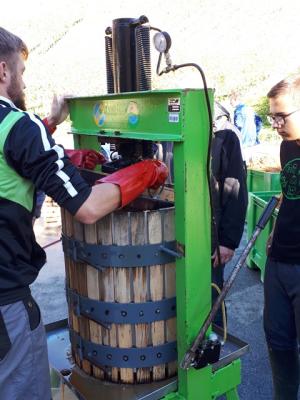
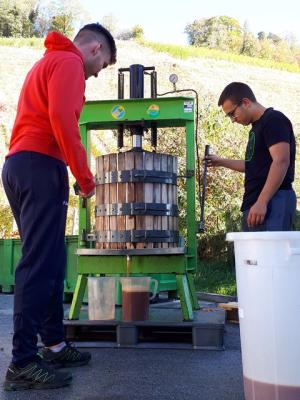
Under the press we had containers in which we collected the juice. When the container was full, we poured the juice into a large bowl. There were 50 liters of apple juice.
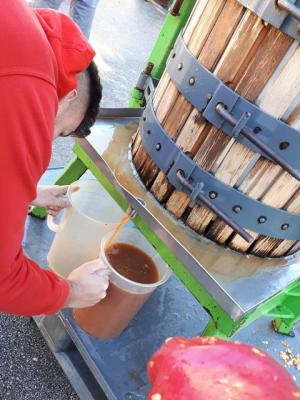
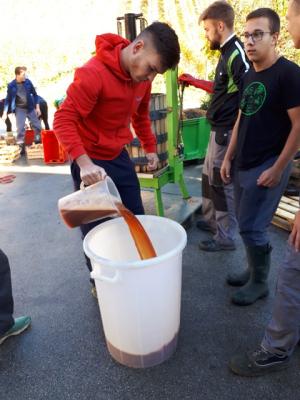
On 50 liters of juice, we added 15 ml of fruit enzyme and 25 g of gelatin and 75 g of bentonite, which helps to clean the juice. We mixed all together and left in the container until the next morning.
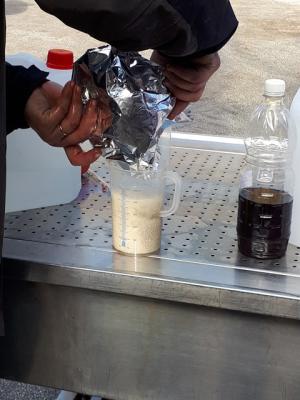
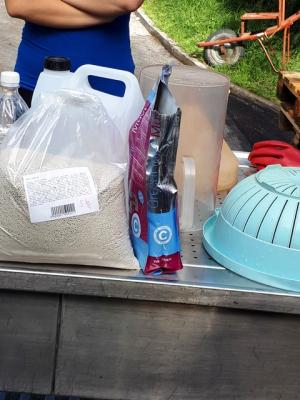
The next morning, we decanted the juice, so we separated the sediment from the juice. We decanted it with a plastic tube.
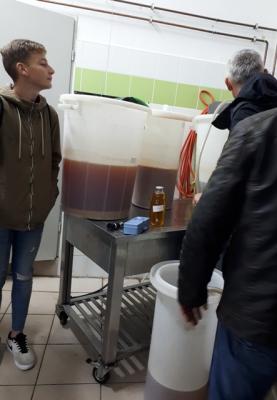
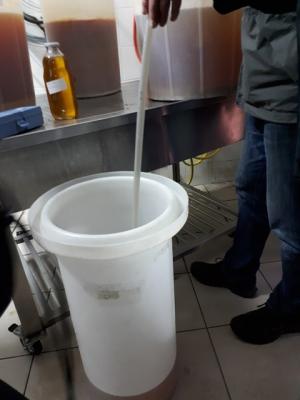
Then, apple juice was filtered with a pad filter.
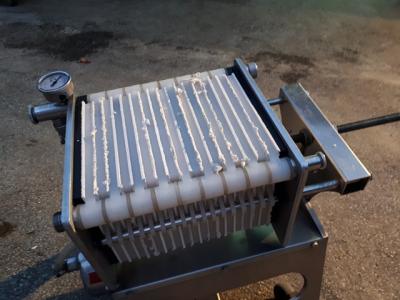
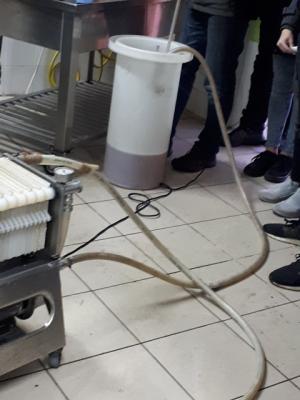
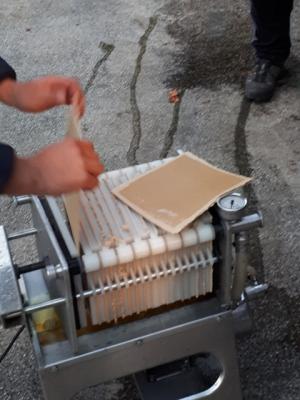
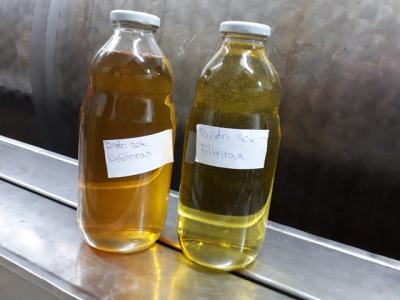
After filtration, the juice was pasteurized with pasteurisator. We destroyed all the microorganisms and thus prolong the storage life of apple juice.
Apple juice was ready for bottling.
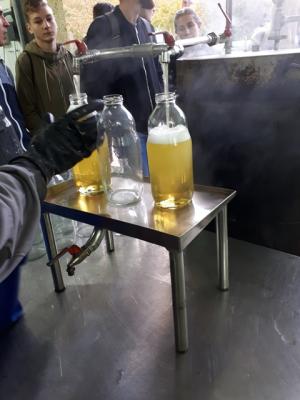
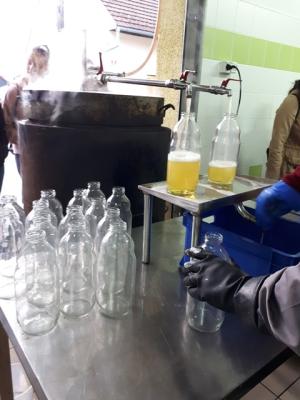
The bottles with heated apple juice were immersed in cold water to cool it as quickly as possible. Then we put the bottles in a box.
Clear apple juice was ready for use.
... link (0 Kommentare) ... comment
The difference between the highest (November 12) and the lowest (November 30) measured temperature in the month was as high as 28.2 °C. This is not such a big surprise, given the very high temperatures in the first part of the month and low in the last part of the month.
The average monthly temperature was also significantly higher than the average of the period from 1981 to 2010 – it was 6.81 °C, and it was 1.71 °C higher than the long-term average. The long-term average for November is 5.1 °C in Maribor. The average temperature was very high in the first half of the month, but fairly constant. In the second half of the month the average temperature dropped by as much as 10 °C. The difference between the average temperature of the coldest (November 30) and the warmest (November 3) day was 18.62 °C. The differences between night and day temperatures were reduced. The difference ranged from 1 to 17 °C, and on average only about 6 °C.
In November, the daily average temperature was only ten times below the average of the period from 1981 to 2010 (5.1 °C). The maximum temperature was nine days above 15 °C, two days above 20 °C, and only 7 days below 5 °C. The lowest temperature in November was -7.3 °C, and the highest temperature was 20.9 °C. In the first eleven months, the average temperature was 1.08 °C higher than the long-term average. In the last month, the average temperature increased by 0.06 °C in relation to the long-term average.
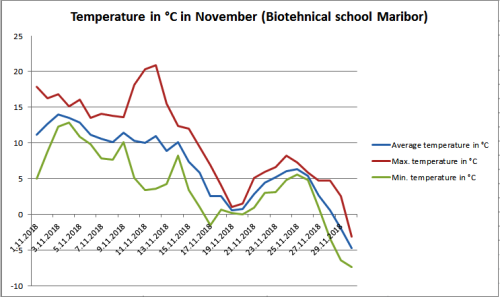
Precipitation data show that there was very little precipitation in November, what is happening in the last half of the year. In November, 86 % of the precipitation dropped, as is the long-standing average. The measuring device detected 59.4 mm of precipitation, which is much less as long as the long-term average (69 mm of precipitation). In the first eleven months, 59 mm less precipitation fell than the long-term average. In the first eleven months we recorded as much as 146 precipitation days or 43.7 % days.
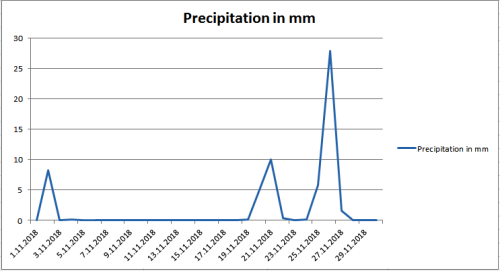
The average relative humidity in November was 89.05 %, which is much more than in October. According to cold nights and more moisture in the air during the day, this was expected.
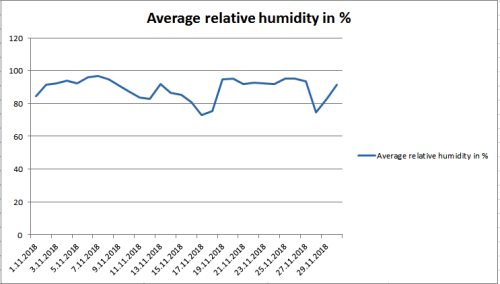
... link (0 Kommentare) ... comment